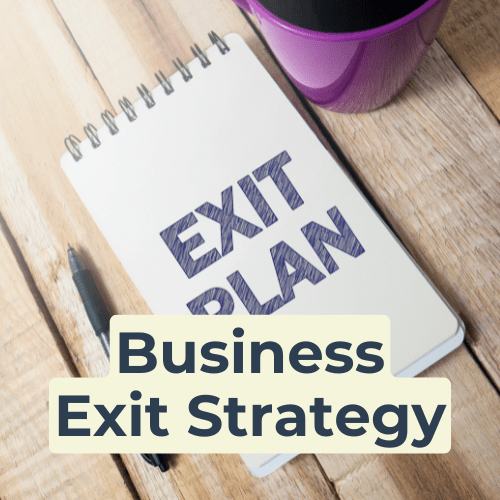
Business Exit Strategy: How to Leave Your Business Without Losing Value or Control
Share
What Is a Business Exit Strategy?
A business exit strategy is a structured plan that outlines how you’ll leave or transition out of your business; whether by selling, succession, management buyout, or wind-down.
It answers questions like:
- Who will take over?
- When will the transition happen?
- How will the business stay stable?
- What do I want to walk away with?
Without a strategy, most owners either exit in panic or leave too much value on the table.
🎙️ New Episode: How to Increase Your Business Valuation
Discover the levers that actually move your valuation multiple. In this episode of Built to Sell | Built to Buy, Sam breaks down the numbers, the metrics, and the mindset that will boost your business worth—whether you're planning to sell soon or just want to build a more valuable business.
Explore more episodes at sampenny.com/podcast
Exit Strategy vs Exit Planning: What’s the Difference?
They work together, but they are not the same.
Exit Planning is the process of preparing your business for sale or transition (cleaning up finances, removing owner reliance, etc.)
Exit Strategy is the actual path you choose to exit — and what that exit looks like for you and the business.
Planning gets you ready. Strategy decides where you're going.
Why Every Business Owner Needs an Exit Strategy (Even if You're Not Ready to Leave Yet)
Having an exit strategy gives you:
- Clarity on long-term goals
- Options if unexpected events occur
- A higher sale price (because you're prepared)
- Leverage in negotiations
- Peace of mind
If you are the key person in the business, the risk of no plan is higher than you think.
The 5 Most Common Exit Strategies for Business Owners
1. Trade Sale (Sell to Another Business)
Often yields the highest price. Buyers may include competitors, suppliers, or strategic investors.
Best for: Growth-focused businesses with strong IP or systems.
Watch for: Earn-outs, cultural mismatch, or operational changes post-sale.
2. Management Buyout (MBO)
Sell to your existing leadership team.
Best for: Businesses with capable, trusted staff and a strong internal culture.
Watch for: Financing complexity and negotiation around roles.
3. Succession (Family or Internal Transfer)
Hand the business to a family member or long-term employee.
Best for: Legacy-driven owners who want continuity.
Watch for: Lack of formal process, emotional tension, undervaluation.
4. Private Equity or Investor Exit
Sell all or part of your business to a PE firm or outside investor.
Best for: Businesses with scale potential, profitability, and clean financials.
Watch for: Loss of control, restructuring, and tight reporting requirements.
5. Wind Down and Liquidate
Not glamorous, but sometimes practical.
Best for: Sole operators with no successor or businesses that are no longer profitable.
Watch for: Tax implications and missed opportunity for selling goodwill or systems.
How to Choose the Right Exit Strategy
Ask yourself:
- Do I want to walk away completely or stay involved?
- Do I want to maximise cash or ensure continuity?
- Who do I trust to take this business forward?
- What matters more; price, people, or legacy?
The right strategy fits your personal goals and your business model.
Key Steps to Create Your Exit Strategy
-
Clarify your personal goals
Retirement? Next venture? Passive income? -
Understand your business’s value
Get a valuation and benchmark your current position. -
Choose your preferred exit path
Identify your ideal and acceptable outcomes. -
Start preparing now
Reduce risks, clean up systems, improve financials. -
Build a transition timeline
Plan your role reduction and knowledge transfer. -
Get legal, tax and financial advice early
Structure your exit to avoid unnecessary costs.
Start With the Right Tools
The best strategy starts with knowing where you stand.
That’s why we created two free tools:
-
Business Valuation Report
Know your current valuation and what’s influencing it. -
Sale Readiness Report
See how buyer-ready your business is and what needs to improve.
Before you go...
You will exit your business. The only question is whether you will do it on your terms or someone else’s.
A business exit strategy isn’t just for now. It is a safety net, a leverage tool, and a future-focused plan that gives you options and control.
Start working on it today, and give your future self the freedom you’ve earned.
Related Reads
- Remove Yourself from Business & the Day-to-Day (Without Losing Control)
- Exit Planning for Business Owners: The Complete Guide to a Profitable and Stress-Free Business Exit
- Don’t Buy a Business Without This: The Investor’s Business for Sale Checklist
- Business Brokers in Australia: How to Find the Right One for Your Business for Sale Deal
- Systemise Your Business: Steps to Build a Business That Runs Without You


